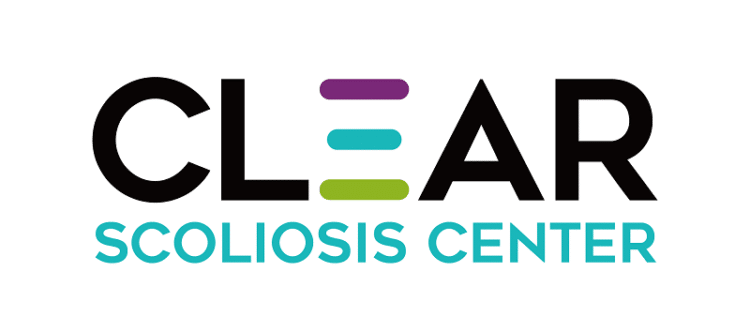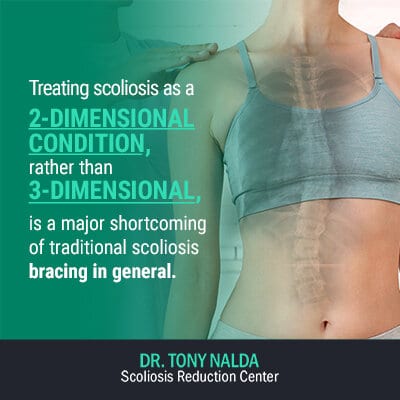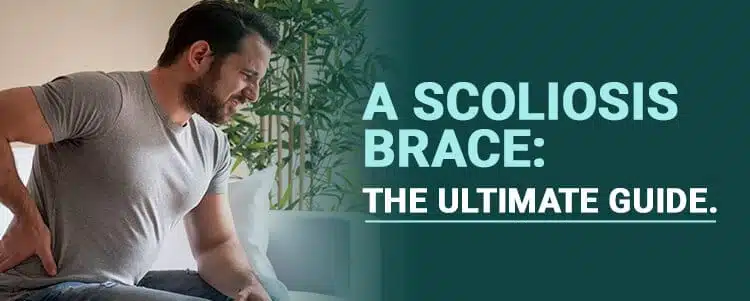
When it comes to a progressive and incurable condition like scoliosis, the chosen treatment path is crucial. From traditional to alternative, current treatment strategies have evolved to combine the benefits of multiple modalities. Scoliosis bracing has been around since the condition’s early days, and while there are many different braces to choose from, not all are created equal. The big difference is whether or not a brace is designed to ‘hold’ or ‘correct’ the scoliosis.
Nighttime braces are a specific type of scoliosis brace designed for children, emphasizing their effectiveness in managing spinal curvature and the importance of compliance for achieving the best results.
Adolescent idiopathic scoliosis, most commonly diagnosed in individuals aged 9 to 16, is a specific category of scoliosis that often requires careful management. Clinical practice guidelines for treatment frequently recommend the use of braces such as the Thoracic Lumbar Sacral Orthosis (TLSO) to manage and correct spinal curvature during the growth phase.
If you or someone you love has recently received a recommendation to wear a scoliosis brace, there is a lot of information to wade through. In an effort to better understand the pros and cons associated with different types of scoliosis braces, please continue reading so you can make the most informed decision possible.
Understanding Scoliosis and Bracing
Scoliosis is a medical condition characterized by an abnormal lateral curvature of the spine. While it can affect individuals of all ages, it is most commonly diagnosed in adolescents and young adults. Scoliosis bracing is a non-surgical treatment option designed to slow or halt the progression of the spinal curve. Typically recommended for patients with a curve between 25-50 degrees on an X-ray, the primary goal of scoliosis bracing is to prevent the curve from worsening over time and to maintain the current degree of curvature. By doing so, bracing helps manage the condition and improve the patient’s quality of life.
The Role of Scoliosis Bracing in Treatment
Bracing is a common facet of scoliosis treatment in children and adolescents; this is because bracing only works if a spine is still growing. It’s most often prescribed for patients with a Cobb angle measurement of 20 or 30 degrees.
As a progressive condition, a large part of any treatment strategy is controlling the level and rate of progression. With many of the traditional bracing options, the purpose of the brace treatment is to reduce the likelihood of the scoliosis worsening and avoid the need for spinal-fusion surgery. The theory behind bracing is that if pressure is placed on the parts of the spine with bad curves, that pressure will stop those bad curves from growing, controlling their progression.
Depending on condition severity, treatment approach, and the type of brace being used, some braces require constant wearing, others are worn at night, and some are worn for large portions of the day. Considering the age group most commonly diagnosed with scoliosis, adolescents 10 to 18 years of age, you can see how compliance can be a challenge. Research indicates a significant positive correlation between the hours of brace wear and the success rate of the treatment. Nighttime braces are particularly effective in managing spinal curvature, and compliance with wearing them is crucial for achieving the best results.
Before we move on to the differences between individual braces, I want to draw attention to the biggest overarching difference that impacts efficacy: the difference between a brace that ‘holds’ the scoliosis and a brace that ‘corrects’ the scoliosis.
Holding vs. Correcting
If you’ve done your homework, you’ve likely come across the two terms ‘holding’ and ‘correcting’ when reading about scoliosis treatment options. While they might seem similar, in terms of treatment efficacy, they mean very different things.
Holding the Spine
The idea behind a lot of traditional bracing and invasive spinal-fusion surgery is to ‘hold’ the spine in a straighter alignment. In terms of making a crooked spine straighter, these methods can be considered successful, but what I want to caution patients and their families about is that a straighter spine held in position can come at a cost; that cost is the spine’s overall strength and flexibility.
The other thing I’d like to point out is that holding the spine in a straighter alignment is doing little to address the actual underlying cause of the deformity and is, instead, just addressing the curvature as a symptom of it.
Correcting the Spine

The difference between holding and correcting is significant. When a crooked spine finds its way back to a straighter alignment through corrective means, the spine’s been manipulated to move in the ways we want it to.
Whether this is accomplished through chiropractic adjustments, corrective bracing, scoliosis-specific exercises and therapy, or a combination of everything, the end result is a spine that’s experienced a correction through natural and functional means; it’s not being held in a better position through artificial means.
Manipulating the spine to move into a corrective position means the spine doesn’t lose its natural strength and flexibility, as it does when it’s simply being held in position.
Because children and adolescents are still growing, they face the highest risk of progression, and also because they’re still growing, their spines can respond favorably to scoliosis bracing as a means of preventing progression from getting worse.
Scoliosis Bracing for Kids
If you’ve done some reading about scoliosis, you’ve likely stumbled across the term ‘early detection’. As a progressive condition, it’s in the very nature of scoliosis to worsen over time; as an incurable condition, treatment efforts are aimed at controlling its progression so that patients can live their best lives throughout treatment and beyond.
When it comes to treating children and adolescents with scoliosis, we want to monitor them closely to see how growth affects their progression. As the number one trigger for progression, growth is obviously not something we can stop from happening, but we can certainly make every effort to counteract the condition’s natural tendency to worsen along with it.
Scoliosis bracing is a common treatment option for kids because they’ve yet to reach skeletal maturity, meaning their spines can still be manipulated to varying degrees. For moderate-to-severe conditions, or when rapid progression is a concern, bracing can be recommended as a means of slowing down progression. The Bracing in Adolescent Idiopathic Scoliosis Trial (BrAIST) demonstrated that bracing is effective in preventing curve progression and reducing the need for surgery in patients with idiopathic scoliosis.
Through a three-point pressure system, traditional braces put pressure on parts of the curvatures we don’t want to keep growing. That squeezing effect, in theory, can slow down progression.
Again, this isn’t doing anything to actually correct the curvature, only to hold it in a corrective position. While bracing is more commonly recommended for younger patients, scoliosis bracing for adults also has its place.
Scoliosis Bracing for Adults
Scoliosis bracing for adults is less commonly prescribed as they’ve already reached skeletal maturity. Another reason is that as growth is no longer a factor with adult patients, rapid progression is not as much of a concern.

When it comes to bracing for adults, if recommended, it’s for different reasons than with younger patients. In younger patients, bracing is mainly recommended to limit progression; in older adults, it’s most often prescribed to reduce pain and limit the need for medication. If an adult with scoliosis is in severe pain, some doctors will prescribe a scoliosis back brace to help reduce their patient’s spinal movement and provide them with support. Depending on the cause and severity of the patient’s condition, bracing recommendations will vary significantly.
That being said, there are two common types of scoliosis braces recommended for adults:
- Rigid bracing – in older adults, hard plastic braces are shied away from as they can cause muscle atrophy and related complications that can accelerate degeneration of the spine. However, rigid braces are sometimes used to apply pressure to the spine to prevent further curvature and manage spinal deformities.
Younger adults sometimes opt for a rigid brace to improve their spine’s overall appearance.
- Flexible bracing – flexible braces are most often recommended for adult patients in need of extra back support and palliative relief during strenuous physical activities.
These are sometimes used for their rehabilitative potential in strengthening the body’s posture for long-term relief.
Now that we’ve looked into the different ideologies behind scoliosis bracing in general, and scoliosis bracing for children and adults, let’s explore some of the defining features of the most popular braces: TLSO Boston brace, Milwaukee brace, Charleston Bending brace, and the ScoliBrace®.
The TLSO Brace
TLSO (thoracic-lumbosacral-orthosis) braces are corset in style and are most often pre-made out of rigid plastic. It focuses on the mid-to-lower spine in order to stabilize the lateral bend of a scoliosis curvature.
The brace comes in small, medium, and large, and the most common TLSO brace design is the Boston brace; this is the most common scoliosis brace used in the United States. It wraps around the patient’s rib cage, hips, and lower back and has to be worn virtually all day: 18-23 hours.
As you can imagine, wearing a Boston brace isn’t comfortable. In fact, it’s designed to be uncomfortable, in part, so that the patient’s body stops the progression.
This is where compliance can become an issue. Imagine a 15-year-old girl wanting to wear a rigid brace all day that restricts her range of motion and can also impair lung function. Let’s also keep in mind that the brace only fits under clothing that’s baggy enough – not exactly in line with the day’s big fashion trends.
Often, once teenagers get to school, that brace comes off and goes in the locker. If the brace isn’t worn the way it’s supposed to be, success rates drop significantly.
Milwaukee Brace
Known as a CTLSO (cervico-thoraco-lumbo-sacral-orthosis) brace, the Milwaukee brace resembles a bulky plastic body jacket and is most often used for treating high thoracic (middle back) curves.
It functions in the same way that many lower-back braces do, with the exception of having a neck ring. The neck ring’s held in place through vertical bars that are attached to the main body of the brace, providing support to the cervical spine.
This type of brace is most effective for curves in the thoracic spine and is regarded as particularly effective when it comes to kyphosis (an excessive outward curve).
The Milwaukee brace should be worn for 23 hours a day to decrease the likelihood of curvature progression, and there are also braces that are designed to be worn only at night.
Charleston Bending Brace
The Charleston Bending brace is designed to be worn at night so that adolescents can reduce their thoracolumbar curves while sleeping. Developed in the 1970s, this brace makes a decent attempt at addressing the compliance issue that sabotages many bracing treatment attempts.

However, the flip side of that is the brace is only designed to be used while in a lying-down position, and many question just how effective it can be when worn only in that one position for a limited amount of time a day.
The Charleston bending brace is molded so that it will conform to the wearer’s body while they’re bent towards their curve’s outward bulge.
The other big issue with this is that it only addresses the bending associated with the scoliosis, not the rotation, and we know that as a 3-dimensional condition, any effective treatment plan has to treat the curvature on all three planes: frontal, coronal, and sagittal.
Treating scoliosis as a 2-dimensional condition, rather than 3-dimensional, is a major shortcoming of traditional scoliosis bracing in general.
Shortcomings of Traditional Scoliosis Bracing
As mentioned earlier, scoliosis braces are still one of the most common forms of treatment for the condition. While some people would take that as evidence of their efficacy, this is where it’s important to do your own due diligence.
The aforementioned braces don’t address the condition’s nature as 3-dimensional; instead, they treat it as 2-dimensional.

In fact, traditional braces such as the Boston and the Milwaukee can do a fair amount of harm due to their squeezing designs.
As the braces are designed to squeeze the spine so that it slows down the bad curve’s progression, that pressure can cause a gradual weakening of the spine.
Anything that weakens an already deformed spine isn’t good in the long-term.
There’s also a growing concern amongst experts that the Boston brace can actually increase the spine’s overall rigidity.
In addition, as most of the squeezing pressure from the brace comes from the sides, rib deformities that are already characteristic of scoliosis can worsen.
Of course, there are also the financial costs associated with getting a scoliosis back brace, and depending on budget, this factor alone could decide whether or not a scoliosis back brace is a viable treatment option.
Scoliosis Brace Cost
When considering different paths of treatment for scoliosis, financial cost should also be considered. When it comes to bracing, the average cost of a traditional scoliosis back brace can vary depending on the design.
Most often, traditional braces will range in price from $5,000 to $10,000. It’s important to remember that this is solely the cost of the brace; this doesn’t include the cost of having the brace fitted, X-rays taken, and any other associated fees. For the more current and innovative ScoliBrace®, the average cost is $4,600.
For people weighing the pros and cons of various forms of treatment, in addition to considering the efficacy of traditional scoliosis bracing, there is also the financial cost and the emotional and physical challenges associated with wearing a brace that can be uncomfortable and cumbersome.
Not a Perfect Fit
A big problem with traditional scoliosis bracing is that they’re not custom fit to each and every patient. While certain adjustments can be made and most braces have size options of small, medium, and large, those standardized sizes most certainly can’t be considered custom.

Considering that the braces have to be worn for most of the day, imagine how something that’s not tailored to your body could make you look and feel. Now, also imagine you’re an insecure tween or teenager dealing with all the rigors and emotional upheaval of day-to-day life, plus a progressive and incurable spinal deformity.
Basically, they see their curvature continuing to worsen and, more importantly, they feel it. That pain and discomfort, paired with how they look and the mobility restrictions they’re faced with, often simply becomes too much. If the brace is considered too painful, uncomfortable, embarrassing, or limiting, many patients refuse to wear it.
Much like teenagers who get their orthodontic braces yanked off too soon because they can’t see the end result through the challenges, regardless of how effective a treatment option is, if it’s not sustainable, it ends up wasting time and resources.
Now, after reading all this, you might be thinking there’s little point to even considering scoliosis bracing as a treatment option. I’m here to tell you that there’s a new brace for a new era of scoliosis correction, and you’re going to want to read all about it.
The ScoliBrace®: What Makes it Different
When it comes to modern scoliosis correction technology, I have to point out that the vast majority of traditional scoliosis braces were designed in the 70s. While some tweaks have been made over the years, the overall design remains the same; this is a major shortcoming.
It’s not the theory behind scoliosis bracing that I take issue with; it’s the many shortcomings of the actual braces that I feel are unnecessary. I felt there had to be a better approach to scoliosis bracing, one that could actually improve the condition, rather than just ‘hold’ it.
Here at the Scoliosis Reduction Center®, we wanted to give our patients another option that could deliver positive results through curvature reduction and functional improvement. The goal of the ScoliBrace® is to treat scoliosis by applying pressure to the spine and ribs to prevent the curvature from worsening, addressing the condition’s 3-dimensional nature.
I touched on it earlier, but the big difference between traditional scoliosis braces such as the Boston and the Milwaukee and the ScoliBrace® is this: the former treats the condition as if it’s 2-dimensional, while the latter addresses its true 3-dimensional nature.
The ScoliBrace® Treats Scoliosis as a 3-Dimensional Condition
A true scoliosis doesn’t just bend, it rotates, and that’s why it’s considered a 3-dimensional condition; any treatment strategy that doesn’t address it as such will fall short.
The other big difference between traditional bracing and the over-corrective ScoliBrace® is that the ScoliBrace® is classed as ‘ultra-corrective’ bracing, meaning it’s designed to actually reduce the scoliosis while it’s being worn.

The ScoliBrace® is custom manufactured and 100-percent bespoke to each and every patient. Picture shelling out big bucks for a finely-made Italian suit. The tailor measures each and every inch of your body, and the care and intricate detailing that goes into the final measurements results in a suit that’s 100-percent customized to suit your body type and all of its curves; our custom ScoliBrace® is much the same.
We’ve taken the very best corrective principles from other bracing designs and combined them with BraceScan: an advanced and modern 3D imaging software. With BraceScan, we take multiple scans of the patient’s body and spine to ensure a completely customized fit for each and every ScoliBrace®.
My treatment plans don’t always necessitate the use of scoliosis bracing, but when a patient’s condition dictates that necessity, the corrective ScoliBrace® is by far the best choice.
Combined with other forms of treatment such as chiropractic adjustments and scoliosis-specific exercise and therapy, the ScoliBrace® represents a new era for scoliosis treatment: one I’m very excited to be a part of.
How Scoliosis Bracing Works
Scoliosis bracing works by applying targeted pressure to specific areas of the back, aiming to straighten the spine and stop the progression of the curve. Each brace is custom-made to fit the patient’s unique body shape and curvature, ensuring that corrective pressure is applied precisely where needed. The brace exerts pressure on the curve while the patient is still growing, influencing the growth of the spine and preventing further worsening of the curvature. Scoliosis braces are most effective in children and adolescents who are still in their growth phase. Typically, the brace is worn for 16-23 hours per day, with breaks allowed for sports and personal hygiene activities.
Choosing the Right Bracing Option
There are several types of scoliosis braces available, each designed to address different needs and preferences. The Boston brace, Wilmington brace, and Charleston bending brace are among the most commonly prescribed options. The choice of brace is determined by the spine doctor in collaboration with the child’s orthotist, based on the specifics of the patient’s condition. The decision between full-time bracing and nighttime bracing is made by the referring physician. Full-time bracing, typically prescribed for 16-20 hours a day, has been shown to have a higher success rate in preventing curve progression when worn for more than 17 hours daily. Nighttime bracing, on the other hand, is usually prescribed for 8-10 hours every night, offering a more flexible option for some patients.
Scoliosis Bracing and Physical Therapy
Physical therapy can play a valuable role alongside bracing in the treatment of scoliosis. It helps improve flexibility and strength, making the brace more comfortable for the patient. While physical therapy alone has not been proven to prevent the progression of scoliosis curves, it can significantly enhance the overall treatment experience. Patients who wear a brace may benefit from physical therapy to improve their posture and spinal alignment. A physical therapist can develop a customized exercise program tailored to the patient’s needs, complementing their bracing treatment and promoting better outcomes.
What to Expect from Scoliosis Bracing
The journey to scoliosis bracing typically begins with a diagnosis from a pediatrician or spine doctor. The referring physician will determine whether a full-time brace or a nighttime brace is needed based on the patient’s condition. The evaluation for a scoliosis brace usually takes 60-90 minutes and includes a clinical postural assessment, measurements, and X-rays. The orthotist will then send the measurements and scans to a design center where the brace will be fabricated. Once the brace is ready, the patient will need to follow a prescribed wearing schedule, treatment plan, and attend regular follow-up appointments. Proper care of the brace, including regular cleaning and avoiding activities that may damage it, is essential for its effectiveness.
How Are Scoliosis Braces Made?
Just as different scoliosis treatment approaches offer patients different potential outcomes, there are a number of scoliosis braces available, but not all are created equal and/or have the same treatment goal.
The goal of traditional bracing is to stop scoliosis from progressing, and it does so via a 3-point pressure system that squeezes the spine into a straighter position, but this type of pressure can actually weaken the spine over time.
In addition, traditional bracing is flawed because it only addresses scoliosis as a 2-dimensional condition, when its rotational component makes it a progressive 3-dimensional condition; corrective braces like the ScoliBrace address it as such.
Traditional braces like the boston aren’t customized to address the specifics of each patient’s body and curvature-type, so they aren’t as comfortable and easy to move in, causing compliance issues.
Traditional braces have changed little in their design over the years, despite learning more about the condition and potential treatment efficacy.
The emergence of corrective bracing represents the culmination of what we’ve learned about the condition, and how it responds to treatment, over the years.
How is the Corrective ScoliBrace Made?
Here at the Center, whenever possible, I rely on the ultra-corrective ScoliBrace to meet my patients’ bracing needs.
Most often used for treating scoliosis in children whose spines are still growing, the ScoliBrace has the ultimate goal of achieving corrective results, and this means actually reducing the scoliotic curve on a structural level because scoliosis is a structural condition.
The ScoliBrace features a high-quality customized design that is held to strict quality protocols by an entire team.
The design team ensures that each brace is bespoke to its wearer through a series of 3D scans, digital X-rays, and photos of a patient’s posture so a 3-dimensional ultra-corrective brace can be designed and made.
Through the use of computer-aided design (CAD) software, the design is based on an algorithm containing the body type, and type of scoliosis, a patient is diagnosed with; this approach ensures the design process is consistent, while allowing each brace to be fully customized for the best potential results.
The ScoliBrace is made from lightweight and durable material that’s padded for additional comfort and opens and closes easily at the front; there are also a variety of colors and patterns available so patients can further customize the appearance of their brace, and the idea behind this is that it will yield better rates of compliance: a big challenge of traditional bracing.
No brace on its own would be enough to correct a scoliosis, but when combined with other forms of proactive condition-specific treatment such as chiropractic care and physical therapy, corrective bracing can help by pushing the spine into a corrective position.
The best time to start scoliosis treatment is always now, but I caution patients, and their families, to ensure they are aware of the differences between the scoliosis treatment approaches, the braces used in each, and the ways in which these differences can affect the spine’s long-term health and function.
Conclusion
Scoliosis is a complex condition. From causation to progression, it’s a condition that often has the medical community scratching its head in search of answers and understanding.
Although we might not understand every variable that affects its development and progression, we’ve come up with a solid foundation from which to develop the best possible scoliosis treatment plans.
When it comes to bracing as a form of scoliosis treatment, there have been a lot of advancements made from the early designs, and those advancements have culminated in the ultra-corrective ScoliBrace®.
The ScoliBrace® uses the ideology behind traditional bracing and addresses its shortcomings by treating the condition as 3-dimensional and making the brace more comfortable, customized, and corrective.
Rather than just holding the spine in a corrective position as the traditional braces do, the ScoliBrace® actually works to move the spine into a corrective position while it’s being worn.
When combined with other forms of proactive treatment, the ScoliBrace® can have impressive results in terms of controlling progression and correcting a curvature without compromising the spine’s natural strength and flexibility.
FAQs
1. Why do I need to wear a scoliosis brace at night?
If your brace is prescribed for full-time wear, this typically includes nighttime use. Since scoliosis progresses most during growth (especially in adolescents), consistent bracing helps prevent curve worsening. A corrective brace, like the ScoliBrace®, is designed to guide the spine into a better position—even while you sleep.
2. What’s the difference between traditional and modern scoliosis braces?
- Traditional braces (e.g., Boston brace):
- Mass-produced, rigid, and bulky
- Squeeze the spine to stop progression (but don’t correct it)
- Uncomfortable to sleep in, leading to lower compliance
- Not adjusted as treatment progresses
- Modern corrective braces (e.g., ScoliBrace®):
- Fully customized for comfort and effectiveness
- Push the spine into a corrective position (not just squeeze it)
- Easier to wear and sleep in due to better fit
- Adjusted as the spine responds to treatment
3. How can I sleep comfortably in a scoliosis brace?
- Choose a customized brace (like the ScoliBrace®) for better comfort.
- Adjust sleeping positions—some find side-sleeping with a pillow between the knees helps.
- Wear soft, breathable clothing under the brace to reduce irritation.
- Follow your provider’s guidance on how long to wear it at night.
4. Can I take my brace off at night if it’s uncomfortable?
No—consistency is key for bracing to work. If your brace is too uncomfortable to sleep in, talk to your provider about adjustments or switching to a more comfortable corrective brace.
5. Are there special nighttime scoliosis braces?
Yes! The ScoliNight brace is designed for younger patients with flexible curves. It’s worn only at night and works best during peak growth phases.
6. Will a scoliosis brace alone fix my curve?
No—bracing is just one part of treatment. For best results, it should be combined with:
- Chiropractic care (to improve spinal alignment)
- Physical therapy (to strengthen supporting muscles)
- Rehabilitation exercises (to maintain correction)
7. How long do I need to wear a brace at night?
This depends on your curve severity and growth stage. Some wear it only at night, while others need full-time wear (20+ hours/day). Your provider will create a personalized plan.
8. What if my brace makes it hard to sleep?
- Ensure proper fit—a poorly fitted brace is harder to sleep in.
- Try different sleeping positions (back or side with support).
- Ask about adjustments—modern braces can be modified for comfort.
9. Can adults sleep in a scoliosis brace?
Yes, but bracing is most effective for growing adolescents. Adults may use braces for pain relief or postural support, but correction is harder after skeletal maturity.
10. How do I know if my brace is working?
Regular check-ups with X-rays or scans will track progress. If your curve stabilizes or improves, the brace is effective. If not, your provider may adjust treatment.





